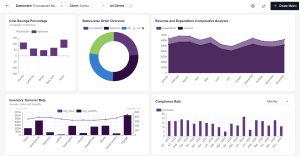Last Updated on August 22, 2025 by Muhammad Ramzan
Procurement has always been a data-driven function. From tracking supplier performance to monitoring spend, decisions have traditionally relied on reports, dashboards, and manual analysis. However, with supply chains becoming more complex and business environments more volatile, the limitations of traditional procurement analytics are clear. Static reports, fragmented systems, and delayed insights no longer meet the demands of today’s enterprises.

This is where Procurement Analytics 2.0 comes in. Powered by artificial intelligence (AI), advanced analytics is enabling procurement teams to move from descriptive reporting—what happened—to predictive and prescriptive intelligence—what will happen and what actions should be taken.
What is Procurement Analytics 2.0?
Procurement Analytics 2.0 represents the next evolution of spend and supplier analysis. Instead of looking backward with static reports, organizations can now use AI-driven tools to generate real-time insights, predict risks, and recommend strategic actions.
It combines several advanced capabilities:
- Data integration from multiple systems (ERP, finance, supplier platforms)
- Machine learning models that detect spending patterns and anomalies
- Predictive analytics that forecast demand, supplier risks, and cost trends
- Prescriptive recommendations that guide buyers on the next best action
- Visualization and dashboards that update in real time
Why Traditional Analytics Falls Short
Traditional procurement analytics typically relied on historical data and manual categorization. While this approach provided visibility, it was often limited by:
- Time lags – Reports generated monthly or quarterly missed emerging risks.
- Data silos – Procurement data spread across multiple systems created blind spots.
- Human error – Manual classification of spend categories often led to inaccuracies.
- Reactive insights – Teams only identified issues after they had already occurred.
Procurement Analytics 2.0 addresses these gaps by automating data cleansing, continuously analyzing transactions, and applying AI models to generate forward-looking insights.
The Power of AI in Procurement Analytics
AI transforms raw procurement data into actionable intelligence by:
- Automated Spend Classification
Machine learning algorithms automatically categorize purchases across thousands of suppliers and complex taxonomies. This reduces errors and ensures accurate reporting at scale.
- Anomaly Detection
AI models detect unusual spending behavior—such as duplicate invoices, off-contract purchases, or inflated pricing—flagging risks instantly.
- Predictive Forecasting
Procurement teams can anticipate future demand, commodity price changes, or supplier performance dips, allowing them to take preventive measures.
- Supplier Risk Scoring
AI analyzes financial data, delivery records, and external news sources to assign real-time risk scores to suppliers. This helps organizations manage supplier relationships more strategically.
- Prescriptive Recommendations
AI not only highlights risks but also recommends corrective actions—such as consolidating suppliers, renegotiating contracts, or reallocating spend.
Benefits of Procurement Analytics 2.0
Enterprises adopting AI-driven analytics achieve tangible outcomes:
- Cost Savings: Identify opportunities to consolidate purchases and negotiate better pricing.
- Process Efficiency: Reduce manual reporting time and accelerate decision-making.
- Risk Mitigation: Detect fraud, non-compliance, and supplier vulnerabilities early.
- Strategic Value: Shift procurement’s role from transactional to data-driven decision-making.
- Agility: Respond faster to market disruptions, inflationary pressures, or supply chain shocks.
Zycus and the Future of Procurement Analytics
Solutions such as Zycus’s Source-to-Pay suite and Merlin Agentic AI exemplify Procurement Analytics 2.0. By integrating spend analysis, supplier management, and contract insights into a single platform, Zycus enables enterprises to:
- Gain real-time visibility across global spend
- Leverage AI-driven dashboards for anomaly detection and predictive forecasting
- Use prescriptive recommendations to optimize sourcing strategies
- Drive compliance and reduce maverick spending through intelligent monitoring
With Procure-to-Pay automation and procurement Intake Management, Zycus ensures that every procurement decision—right from request intake to supplier payments—feeds into a unified analytics layer, creating a closed loop of data-driven intelligence.
Conclusion
Procurement Analytics 2.0 marks a fundamental shift in how organizations manage spend and suppliers. No longer limited to static dashboards, procurement leaders now have access to AI-powered tools that predict risks, prescribe actions, and deliver measurable ROI.
As enterprises continue to face economic uncertainty, supply chain volatility, and regulatory pressures, adopting AI-driven analytics is no longer optional—it’s essential. With platforms like Zycus Merlin Agentic AI, organizations can truly turn procurement data into decisions that shape business resilience, cost savings, and long-term growth.







